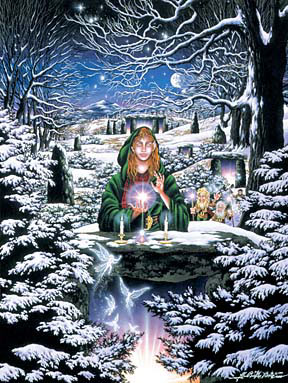| CHRISTMAS: THE WAY IT BEGAN 
If truth be told, the holiday of Christmas has always been more Pagan than Christian, with its associations of Nordic divination, Celtic fertility rites, and Roman Mithraism. That is why both Martin Luther and John Calvin abhorred it, why the Puritans refused to acknowledge it, much less celebrate it (to them, no day of the year could be more holy than the Sabbath), and why it was even made illegal in Boston! The holiday was already too closely associated with the birth of older Pagan gods and heroes. And many of them (like Oedipus, Theseus, Hercules, Perseus, Jason, Dionysus, Apollo, Mithra, Horus and even Arthur) possessed a narrative of birth, death, and resurrection that was uncomfortably close to that of Jesus. Ultimately, of course, the holiday is rooted deeply in the cycle of the year. It is the Winter Solstice that is being celebrated, seed-time of the year, the longest night and shortest day. It is the birthday of the new Sun King. On this darkest of nights, the Goddess becomes the Great Mother and once again gives birth. And it makes perfect poetic sense that on the longest night of the winter, there springs the new spark of hope, the Sacred Fire, the Light of the World. That is why Pagans have as much right to claim this holiday as Christians. Perhaps even more so, as the Christians were rather late in laying claim to it, and tried more than once to reject it. There had been a tradition in the West that Mary bore the child Jesus on the twenty-fifth day, but no one could seem to decide on the month. Finally, in 320, the Catholic fathers in Rome decided to make it December, in an effort to co-opt the Mithraic celebration of the Romans and the Yule celebrations of the Celts and Saxons. There was never much pretense that the date they finally chose was historically accurate. Shepherds just don't “tend their flocks by night�?in the high pastures in the dead of winter! But if one wishes to use the New Testament as historical evidence, this reference may point to sometime in the spring as the time of Jesus's birth. This is because the lambing season occurs in the spring and that is the only time when shepherds are likely to watch their flocks by night -- to make sure the lambing goes well. Knowing this, the Eastern half of the Church continued to reject December 25, preferring a date fixed by their astrologers according to the moon. Thus, despite its shaky start (for over three centuries, no one knew when Jesus was supposed to have been born!), December 25 finally began to catch on. By 529, it was a civic holiday, and all work or public business (except that of cooks, bakers, or any that contributed to the delight of the holiday) was prohibited by the Emperor Justinian. In 563, the Council of Braga forbade fasting on Christmas Day, and four years later the Council of Tours proclaimed the twelve days from December 25 to Epiphany as a sacred, festive season. Of course, the Christian version of the holiday spread to many countries no faster than Christianity itself, which means that Christmas wasn't celebrated in Ireland until the late fifth century; in England, Switzerland, and Austria until the seventh; in Germany until the eighth; and in the Slavic lands until the ninth and tenth. Not that these countries lacked their own mid-winter celebrations of Yuletide. Long before the world had heard of Jesus, Pagans had been observing the season by bringing in the Yule log, wishing on it, and lighting it from the remains of last year's log. Riddles were posed and answered, magic and rituals were practiced, wild boars were sacrificed and consumed along with large quantities of liquor, corn dollies were carried from house to house while caroling, fertility rites were practiced (girls standing under a sprig of mistletoe were subject to a bit more than a kiss), and divinations were cast for the coming Spring. Many of these Pagan customs, in an appropriately watered-down form, have entered the mainstream of Christian celebration, though most celebrants do not realize their origins. The custom of lighting a Yule log is an ancient Druid practice. A log, usually of the God-related oak tree, is carved into a small section which is brought into a dwelling. Holes are drilled into the log and candies inserted. The entire log is then decoratively covered with holly and evergreens to represent the intertwining of God and Goddess, or male and female elements. Hopes for fertile crops, herds, and families are invested in the Yule log image. Consider the habit of putting up lights. The profusion of lights on house and tree at Christmas time is a carry-over of the candles and fires lit in sympathetic magic to lure back the waning sun. Today it's still an Irish custom to leave lights burning all through the house on midwinter night to honor the sun's return. The Christmas wreath is a symbol of the wheel of the year. The tradition of gift giving during this season may have its roots in Rome. The celebration of Saturnalia was a new year's festival of Pagan Rome where gifts were given in honor of loved ones who had died during the previous year. Early Roman explorers brought this tradition to Ireland where it remained as part of the Yule celebration. Other images at Christmas are kings and birds. Both have their roots in Druid tradition. The Holly King (King of the waning year) does battle with the Oak King (King of the waxing year). Vestiges of fire Holly King can be seen in our modern Santa Claus, who also wears red, dons a spring of holly in his hat, lives but one night a year, and drives a team of eight deer. Eight is symbolic of the eight annual cerebrations and deer are sacred to the Celtic gods. The other battle image is of birds such as the robin, symbolic of the waxing year, and the wren, symbolic of the waning year. Pine trees were decorated at this time of year with images of what people wished the waxing year to hold for them, such as fruit for successful harvest, love charms for happiness and nuts for fertility. There was no absolute standard about ending the Christmas season with Epiphany, and many carried it through to forty days after Christmas, the date of an ancient pagan festival on February 2. This is now celebrated as Candlemas, or the Feast of the Purification of the Virgin, or alternatively as the Presentation of the Infant Jesus in the Temple. In one of the most elaborate processions of the year, all parishioners came to Mass with a penny and a candle blessed before the procession, both of which were offered to the priest as part of the parochial duties of the faithful. Other candles were blessed and taken away by the faithful to be used for such things as giving comfort during thunder storms or while sick or even dying. Such candles were thus important for giving people a light of solace in the face of hostile forces and stressful events. And thus Candlemas was a closure for the long season commencing with Advent that drew Medieval Christians to concentrate on the miraculous gift to humanity of Christ, and the promise of salvation, while leaving at the same time space for fun, feasting, and socializing. 
Backgrounds & page design by ForeverAmber Animated wreath from Jo's World
|
 Free Forum Hosting
Free Forum Hosting